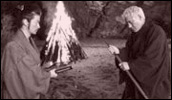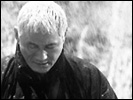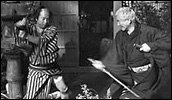Zatoichi
- Year
- 2003
- Original title
- Zatoichi
- Japanese title
- 座頭市
- Director
- Cast
- Running time
- 116 minutes
- Published
- 6 October 2003



by Jasper Sharp
It's been six years since Takeshi Kitano lit up critical skies with the sublime Fireworks (Hana-Bi, 1997), the summation of a body of work that had him labelled as one of the most idiosyncratic and interesting directors to have emerged from Japan in decades. Since then, with the cute but cloying Kikujiro, the entertaining but ultimately flawed attempt at crossing international borders of Brother, and the pretty but vacant Dolls, the output of Japan's most internationally-feted director has left a little to be desired.
To cynics, his latest film and first foray into costume drama, Zatoichi, looked almost certain to continue this downward parabola. The potential pitfalls of stepping into the shoes of one of Japanese cinema's most fondly remembered icons, Shintaro Katsu, as Zatoichi, the blind masseur and master swordsman who sliced and diced his way through over a score of titles for Daiei throughout the 1960s and 70s (26 films, to be exact) were obvious. After all, the veteran actor Katsu (who died of throat cancer in 1997) had exclusively made the role his own in titles such as The Tale of Zatoichi (Zatoichi Monogatari, dir. Kenji Misumi, 1962), Zatoichi: The Blind Swordsman's Return (Shin Zatoichi Monogatari, dir. Kazuo Mori, 1963), and Zatoichi and the One Armed Swordsman (Shin Zatoichi: Yabure! Tojin-ken, dir. Kimiyoshi Yasuda, 1971), even taking up the directorial reins himself for Zatoichi in Desperation (Shin Zatoichi Monogatari: Oreta Tsue, 1972) and the 1989 comeback film Zatoichi, the last entry in the series prior to Kitano's new reworking.
Fortunately, more than just a neat marketing gimmick, Zatoichi sees Kitano back on triumphal form with his best film in years. An unashamed crowd-pleaser, it sees him broadening his appeal beyond the foreign arthouse and cult circuits with his most polished and accessible film to date. It proved a rousing success on its international premiere at the 60th Venice Film Festival in 2003, where Kitano picked up the Silver Lion award for best director (a repeat victory at the festival where Fireworks won the Golden Lion in 1997), days before snagging the People's Choice audience award at the 28th Toronto International Film Festival.
Though the 'jidai-geki' (period drama) movie has seen a slight resurgence in the past year or so with the likes of Yoji Yamada's Twilight Samurai (Tasogare Seibei, 2002) and Yojiro Takita's When the Last Sword Is Drawn (Mibugishiden, 2003), its lowly, more action-driven sub-genre chanbara seems to have fallen out of favour with modern audiences. Aside from a few tongue-in-cheek reinventions such as Kaizo Hayashi's Zipang (1992), Hiroyuki Nakano's Samurai Fiction (1998) and Ryuhei Kitamura's Azumi (2003), its popularity has tailed off dramatically since its heyday over thirty years ago, when the screens were jam-packed with the endless serials dominated by the likes of Crimson Bat (Mekura no Oichi), Wicked Priest (Gokuaku Bozu) and Lone Wolf (Kozure Okami). Today, as a genre, chanbara is as deeply unfashionable as the western is in America.
Though references to Shintaro Katsu's pop-cultural icon have manifested themselves before in his work, lampooned in both his TV comedy in the 1980s and a sequence in the hare-brained Getting Any?, Kitano has mentioned that he was no particular fan of the original series of films. The impetus for the remake came instead from Chieko Saito, the matriarchal 70+ year-old former owner of a string of strip theatres across Tokyo, who put up approximately 15% of the film's budget. It was at her insistence that Kitano agreed to take on the project as a homage to the original Zatoichi actor, a former personal friend of hers.
Kitano pretty much had carte blanche with this new version, but aside from the post-modern touch of playing Zatoichi with his hair bleached peroxide blonde (apparently done beforehand and not for the film itself), he stays remarkably true to the essence of both chambara and to the central character. The story is simplicity itself, a tale of justice and retribution as our hero shuffles into a small rural town overrun by petty official corruption and a gang of mobsters led by Ginzo (Kishibe). Here he comes head to head with a taciturn wandering samurai Hattori (Asano), who has soon entered Ginzo's employ as a mercenary in order to pay for the treatment of his sick wife (Kore-eda regular Natsukawa). He also teams up with Okinu and Osei, a pair of beautiful sisters masquerading as dancers who, as they seek revenge for the murder of their parents, may not quite be all they seem.
Kitano has consciously pitched Zatoichi at a more mainstream Japanese audience, for the first time making extensive use of moving cameras as opposed to his more characteristically static and concise approach to the action, and paying immaculately close attention to period detail. At the same time he manages to successfully subvert the material in service of his own directorial personality without bringing undue attention to his style and technique.
Long praised in the West for foregrounding a minimalist "Japanese" aesthetic in his works, in this instance Kitano's emphasis on the "traditional" is obviously rendered in the setting and the costumes. It also seeps its way into the fabric of the film itself in its most stylish sequences, in which the screen is broken up into precisely balanced compositions of simple geometric components such as flat, two-dimensional planes and the elliptical forms of parasols and peasant's hats. Alongside such striking images as a spinning top balancing on a fan being held up in front of its circle of wide-eyed admirers, the film's technical highpoint has to be an exquisitely performed traditional dance (odori) by one of the deadly kimono-wearing sisters, shot perpendicular to the action and cross-cut with a similar sequence from the dancer's childhood.
But aside from the look of the film, there are other aspects that betray the hand of the master. Rather than the elaborately orchestrated poetic sequences of the archetypal chanbara piece (excepting a memorable scene of carnage played out on a beach in the pouring rain), the violence is generally sporadic, clean and sharp, with the blood-letting rendered as computer-generated spurts. Typically Kitano also lightens the brutality with more comedic asides. As Zatoichi is introduced in the first frames, eyes clamped firmly closed, shambling harmlessly along a deserted country road, he runs into a group of robbers who mistakenly label him an easy target. During the resulting mêlée, as Zatoichi slashes his way through his attackers, one of them receives a painful nick from the flailing sword of an associate standing next to him.
The distracting games played out in the mid-section by Zatoichi's merry band of renegades, before events erupt in the inevitable orgy of bloodshed, is of course pure Kitano, a narrative device that has found itself re-staged in many of his films following its most efficient deployment in Sonatine. A judicious use of flashbacks detailing the sub-stories of all the major players also fleshes out the characters to a far more substantial degree than audiences of the original chanbara series may be accustomed to.
One major departure from Kitano's previous work is the absence of Joe Hisaishi in the role of composer, here replaced with Keiichi Suzuki from the group Moonriders (whose previous film credits include the soundtrack for Uzumaki). With no disservice meant to the excellent Hisaishi, Suzuki's rhythmic score brings a whole new dimension to the images, integrating with the syncopated ambient sounds of swords and staves clashing, workmen's tools, peasants splashing in their fields, and the hypnotic loop of rain falling. This percussive fugue builds, gathering momentum until it reaches critical mass in the stunning Stomp-inspired tap dance routine (choreographed by The Stripes) that sees all of the cast, clad in wooden geta clogs, assembling for the colourful, show-stopping finale.
By continuously attempting to escape from his high-profile media persona in Japan, throughout his career Kitano's cinematic oeuvre has evolved in intriguing directions. Up til now, however, he has yet to attain a significant commercial hit back at home. Though he has always had the Japanese media at his feet, something his new plaudits from Venice look set to cement even further, with Zatoichi he now has the Japanese public on their feet, lining up at the box office.
Filled with such powerful sequences as this exuberant end coda lingering in the memory long after the film has finished, in a year in which Tarantino's Kill Bill and Ed Zwick's The Last Samurai look set to have the eyes of mainstream audiences focused squarely back on the East, with this perfectly realised work Kitano finds himself at last in the perfect situation to capitalise on this rekindled interest in Japan. Effortless and uncontrived, Zatoichi is pure cinematic magic, so go see it.